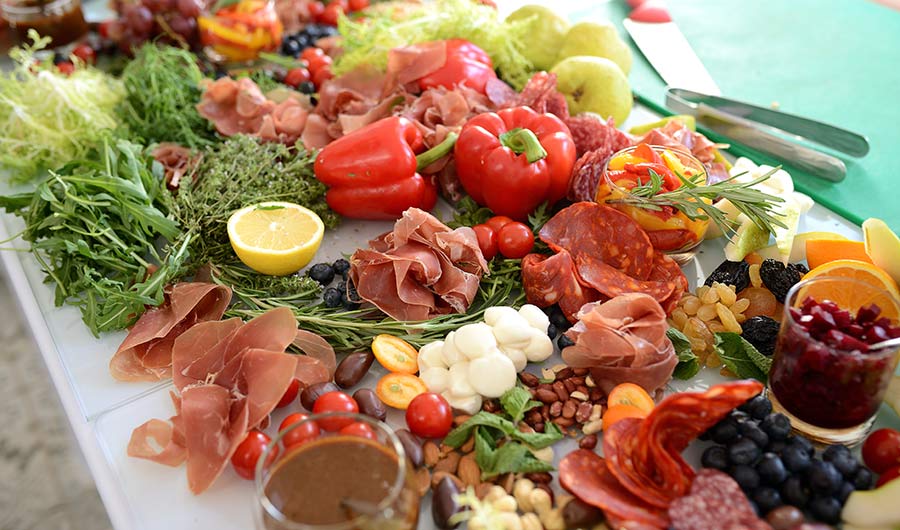Studying Food's 'Dark Matter' Could Help Illuminate Diet's Ties to Health

(IInside Science) -- For decades, scientists have tried to understand how different elements in food -- say vitamin C in an orange or selenium in garlic -- affect people’s health. But the USDA and research databases track only about 150 key nutritional components out of the roughly 26,000 biochemicals known to be present in food.
Researchers want to gather data and start crunching the numbers to learn more about what happens when those biochemicals reach the body.
"We set out to say, how can we combine info about food and disease causation," said Albert-László Barabási, a network scientist at Northeastern University in Boston.
Barabási studies biological networks and their role in human disease. "We have all this data coming from genetics, which can explain 10 to 20% of disease causation," he says. "Where’s the rest? From a person’s environment -- and biggest piece of environment is food."
In a new paper published this week in the journal Nature Food, Barabási suggests how scientists can start to tackle what he calls the "dark matter" of food with machine learning and a more systematic approach to studying the many different variables, using what’s known as network medicine.
For example, each person’s eating patterns define a unique daily biochemical barcode, in what researchers have dubbed the "foodome," derived from other areas of research that characterize large amounts of biological information, such as the genome and biome. It could be possible to study this foodome using image-based daily food diaries and combining them with genomics and disease history.
"We will not really understand how we get sick if we don’t solve this puzzle," said Barabási. After all, diet- and behavioral-induced diseases such as diabetes and heart disease are responsible for a large fraction of deaths in the United States. "To address this health crisis, we have to start asking the questions: What exactly is in the food? Which compounds are making us sick, and which are beneficial to us?"
More stories about the science related to food from Inside Science
The Environmental Benefits of Making Gin from Peas
Physics Can Help Develop New Foods -- Like Crispy Jellyfish Chips
The Scientist's Guide to the Perfect Fondue
Alexander Michels, a research associate at the Linus Pauling Institute at Oregon State University in Corvallis, said he welcomes the suggested approach. Food science has become reductionist over the last decade, focusing on one molecule, either given to people or to a cell culture, and testing the effects of one thing at a time. But, of course, the health effects of food are probably not that simple.
"We try to look at things in isolation, but no one is in isolation," he said. "People are exposed not only to things people are trying to test, but everything else we eat every day." When you add in the additional influence of bacteria, yeast and fungi in a person’s body, and how they all react in different ways, it makes it very tricky to understand the effect of one particular compound.
Take EGCG, for example. That’s the polyphenol compound that gives green tea its health benefits, including blood glucose-lowering and anti-inflammatory effects. When someone takes EGCG as a supplement, what shows up in the bloodstream is not that compound, but instead, microbial digestion products produced after microbes in the body digest it and spit out a new chemical compound.
"So is it the EGCG that causes the benefits, or is it all these other things that the microbes are spewing out that makes it good?" Michels asked. "Or does the EGCG change how the microbes grow and therefore different microbes are showing up, causing the beneficial effects that we associate with green tea extract?"
Another example is fruits and vegetables -- always touted as a part of a healthy diet, they are associated with longer life and less disease. But researchers want to go deeper to tease out what about them exactly is the part that keeps people healthy. Is it the vitamins? The fiber? Do they change the microbiome? Researchers haven’t been able to say.
"We need to stop taking the approach of these large studies of how people eat and trying to relate that to disease, and get to the basics of a biochemical level of what does that food we eat turn into," said Michels. "Once we can start teasing that apart, then we can say, okay, what does this do to the liver or the brain and maybe we can build back up to disease."
Nik Sharma, a molecular geneticist turned food writer who is working on a science-based cookbook, said the approach was extremely ambitious. "What they’re trying to get into is personalized medicine and personalized nutrition goals," he said.
One area where Sharma sees a potential for improvement is in calculating nutritional information -- right now, it’s calculated using raw, not cooked, food. So, if you take an avocado -- a fruit that’s rich in antioxidants -- and apply high temperatures, all the antioxidants get burned off. Similarly, vitamin C is unstable, so cooking a red pepper, for example, will rob it of some of its nutritional value. Even a humble slice of bread has a different nutritional value after it is toasted.
Still, Sharma sees potential in systematically connecting the dots between different parts of food, and what it does to us -- even though it will be a challenging and long process. "When I was in school, individualized medicine was something I dreamed about," he said. "We’ll eventually get there. This might be the start."
